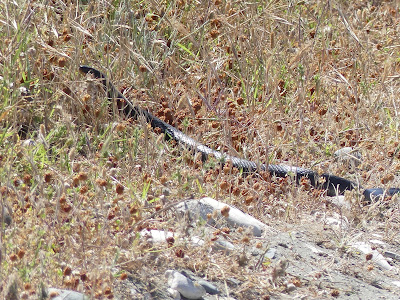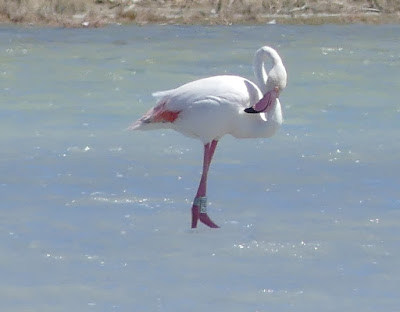Glossy Ibis
Large White
At the rabbit hutch pools 10 Temminck's Stint were on the pool with 14 Little Stint. Wood Sandpiper numbers are on the decline and there was only one here. There were also 18 Ruff, 5 Black-winged Stilt, a Common Sandpiper and 4 Kentish Plover.
It was quiet in the main gravel pit area. The single Greater Flamingo was still present and we found a single Spotted Flycatcher. We did manage to capture an image of a Black whip snake. We have seen a few of these, but they are usually too quick to photograph. These snake can reach a length of 3 metres. They are considered the longest snake found in Europe. The black colouring does not develop until the individual has reached 5 to 6 years old. Until then. they have a brick orange colour with brown spots. The usual diet is small rodents, birds, lizards and smaller snakes. They are not poisonous but considered very aggressive when threatened and will bite. A bite may be prolonged due to the curvature of the fangs. They are found in agricultural and open areas with scattered trees and bushes.
Black Whip Snake
We stopped in at Bishop's pool, our first stop here this trip as we recalled how stagnant and apparently toxic (dead birds seen floating on the water) the pool had been in November. Since then there has been much rain, leaving the water level too high for waders, but at least the water quality seems to have improved. In addition to singles of Coot, Moorhen and Squacco Heron the Little Grebes and Ferruginous Ducks had bred,
One of three adult Ferruginous Duck that attempted to draw our attention......
while this female moved into cover with 11 ducklings. The other 6
young made a break for it on their own.
There were 5 Bee-eaters overhead while we visited the pool. It was very windy and the area that we'd parked seemed an attraction to some dragonflies.
Broad Scarlet
Slender Skimmer
Akrotiri Salt Lake provided more habitat for migrant and resident waders. The Avocet (4) were probably the least expected birds present in addition to Ruff (8), Black-winged Stilt (9), Wood Sandpiper (7), Little Egret (12), Little Stint (29), Kentish Plover (10), Squacco Heron (1) and an Eleanora's Falcon (1).
Eleanora's Falson
Avocet
With the sand less wet now, some birder's drive right up to the water's
edge where there are nesting Kentish Plover present.
Lady's Mile now held greater numbers of Curlew Sandpiper, Broad-billed Sandpiper and Flamingos.
Curlew Sandpipers
Broad-billed Sandpiper
The flock of Flamingos now numbered 80+. Closer examination revealed two birds marked with white darvics. These were surprisingly difficult to see considering the size of these birds and the 'scope was needed to get precise details.
KFVB
T/BFS
T|BFS, black letters on white ring, ringed in Turkey c 2004 at Çamaltı Tuzlası, Gediz Deltası (Turkey) and oddly the other KFVB, black letters on white ring, ringed 2015 Etg. du Fangassier (France) - confirmation awaited for both. The interesting point if the original ringing sites are confirmed, is where did a bird from Turkey meet up with a bird from France, and what made one potentially stay on its eastern European migration route and the other switch from Western Europe to the East? This sort of information only comes from colour ringing projects or radio trackers.
Other observations were Little Egret (12), Kentish Plover (5), Curlew Sandpiper (15), Ringed Plover (5), Broad-billed Sandpiper (8), Ruff (1), Little Tern (17) Little Stint and Greater Flamingos.
A Spectacled Warbler was seen near the Zakaki marsh outflow and a Redstart was on the fence around the pylons.















